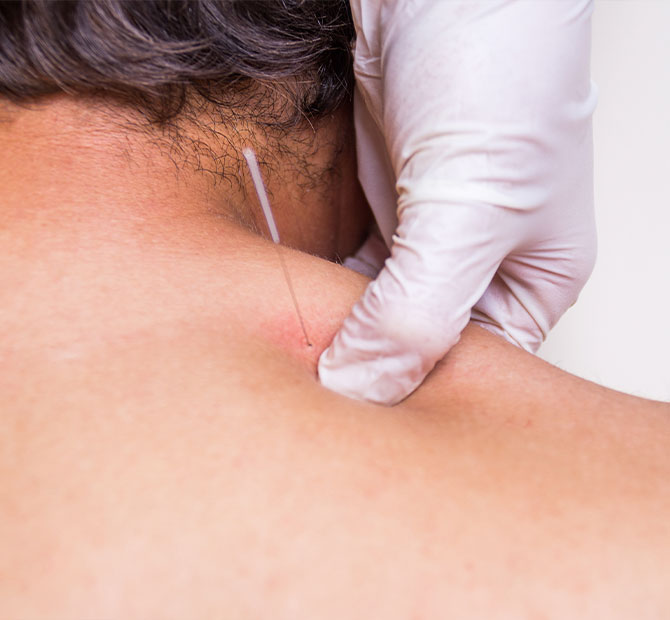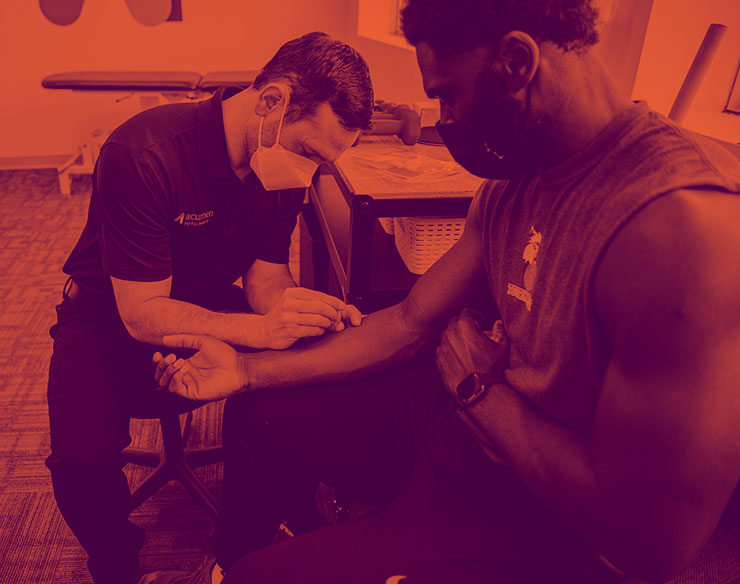Acupuncture at Acumen
Acupuncture is fast becoming one of the most popular methods of treatment in the manual therapy world. Acupuncturists, chiropractors, and physiotherapists are the most common practitioners to have this tool in their arsenal. Treatments involve the use of very thin sterile and disposable needles (slightly thicker than a human hair) inserted into specific tissues. The use of acupuncture by different practitioners varies greatly. However, at its core, research supports a change in local chemical response that has an effect on pain perception1 and inflammation2,which can help to improve motion.
There are three main types of needling/acupuncture described below:
Dry Needling:
Dry needling is very common among chiropractors and physiotherapists. The term “dry” refers to the fact that there is no injection with the use of the needle. Once a needle is inserted into a muscle, it is then moved around (called “pecking”) to stimulate a local twitch response. This can cause a temporary mild ache but creates reflex relaxation of that muscle. A very similar technique called Intramuscular Stimulation (IMS) needling is also commonly practiced.

Electroacupunture:
The addition of electricity is also common with acupuncture. This makes muscles that are inserted with needles twitch without pecking around and can be left on for around 5-10 minutes. Multiple locations can also be done at the same time, increasing the number of areas that can be treated in a single session.

Traditional Chinese Medicine (TCM) Acupuncture:
TCM involves a system of diagnostic and treatment protocols related to “meridians” as well as balancing out energy (“qi”) in one’s body via queues from a history and pulse check. Typically, treatments last an hour. At Acumen, Functional Acupuncture (dry needling and electroacupuncture) is practiced rather than TCM Acupuncture.

Functional Acupuncture includes Dry Needling and Electroacupuncture. These techniques are advantageous in many scenarios. It can be used to help stimulate surrounding muscles post surgery or injury, decrease pain and tension from repetitive stress injuries, decrease local inflammation from an injury and help modulate nerve function and input (e.g. carpal tunnel, sciatica). It can also improve functional status3 (day-to-day) and help improve recovery4. Needling is often more comfortable than other modes of manual therapy and is often described as painless. One of acupuncture’s best advantages is that it can be done passively in scenarios where a patient is in acute or intense pain, or is having difficulty moving.
Currently, Functional Acupuncture (dry needling and electroacupuncture) can be booked with Dr. Brian Boisvert at the Calgary clinic. Call to book today!
References
- Audette, J. F., & Ryan, A. H. (2004). The role of acupuncture in pain management. Physical Medicine and Rehabilitation Clinics of North America, 15(4), 749–772. https://doi.org/10.1016/j.pmr.2004.03.009
- Lv, Q., Wu, F., Gan, X., Yang, X., Zhou, L., Chen, J., He, Y., Zhang, R., Zhu, B., & Liu, L. (2019). The involvement of Descending pain inhibitory system in Electroacupuncture-Induced analgesia. Frontiers in Integrative Neuroscience, 13. https://doi.org/10.3389/fnint.2019.00038
- Liu, L., Huang, Q. M., Liu, Q. G., Thitham, N., Li, L. H., Ma, Y. T., & Zhao, J. M. (2018). Evidence for Dry Needling in the Management of Myofascial Trigger Points Associated With Low Back Pain: A Systematic Review and Meta-Analysis. Archives of Physical Medicine and Rehabilitation, 99(1), 144–152.e2. https://doi.org/10.1016/j.apmr.2017.06.008
- Lin, Z. P., Lan, L. W., He, T. Y., Lin, S. P., Lin, J. G., Jang, T. R., & Ho, T. J. (2009). Effects of acupuncture stimulation on recovery ability of male elite basketball athletes. The American Journal of Chinese Medicine, 37(3), 471–481.

